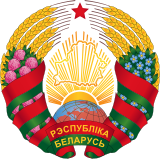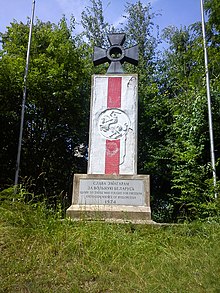Belarusian Americans
Беларускія амэрыканцы | |
|---|---|
| Total population | |
| 600,000[1] (without descendants) | |
| Regions with significant populations | |
| New York, New Jersey, Cleveland, Chicago, Los Angeles, Detroit | |
| Languages | |
| Belarusian, Russian, American English | |
| Religion | |
| Predominantly Orthodoxy, Roman Catholicism, Judaism | |
| Related ethnic groups | |
| Russian Americans, Ukrainian Americans, Rusyn Americans, other Slavic Americans |
| Part of a series on |
| Belarusians |
|---|
 |
| Culture |
| By regions |
| Closely related peoples |
| Religion |
| Languages and dialects |
| Topics |
Belarusian Americans (Belarusian: Беларускія амэрыканцы, Biełaruskija amerykancy) are Americans who are of total or partial Belarusian ancestry.
History
There is an assumption that the first Belarusian settlers in the United States, who settled there at the beginning of the 17th century in Virginia, could have been brought as Slavic slaves by Captain John Smith, who visited Belarus in 1603.[2] The first wave of mass emigration from Belarus started in the final decades of the nineteenth century and continued until World War I. They emigrated to the United States via Libava (Liepāja, Latvia) and northern Germany. When they arrived, most settled in New York, Philadelphia, Boston, and Baltimore. However, most of these first Belarusians were registered either as Russians (those who were Orthodox Christians) or as Poles (Roman Catholics).[2] Furthermore, even today, those who descend from pre-World War I immigrants often use the more archaic term "White Russian" to describe their ancestry instead of "Belarusian".
Demography

According to the 1990 US Census, only 4,277 respondents claimed Belarusian ancestry; there are no reports as to the estimated population from the 2000 census.[3] The precise number of Belarusian Americans is difficult to determine, as census and immigration statistics did not historically recognize Belarusians as a separate category, as the Belarus was for a time part of the Russian Empire and then the Soviet Union when early immigrants arrived.[citation needed] Many of them were recorded as Russian or Polish, depending on the region of Belarus where they were born.[citation needed] In addition, the term "Belarusian" only became common near the end of the Soviet Union's existence, and most persons of Belarusian ancestry in the United States would be unaware of the term, referring to themselves as "White Russian" rather than "Belarusian".
Since it was customary in American English of that time to use a historical Ruthenian designation for various East Slavic peoples, Belarusians in the USA were sometimes referred to as White Ruthenians, and their first newspaper, Belaruskaja trybuna (Belarusian: Беларуская трыбуна), that was published since 1926 by the Whiteruthenian National Association, had an English subtitle: Whiteruthenian Tribune.[4]
The largest concentrations of Belarusian Americans are in the metropolitan New York area, New Jersey (especially Highland Park and South River), Cleveland (and its suburbs), Chicago (recent immigrants concentrated around Wheeling), Los Angeles, Sacramento (largely around Orangevale and North Highlands) and Detroit.
There were several waves of Belarusian influx into the USA, one before the Russian Revolution, then in 1919-1939 from Western Belarus, then in the late 1940s-early 1950s (after the Second World War), and after the collapse of the USSR in the 1990s.
One major group of Belarusian immigrants to the U.S. are Belarusian Jews who migrated starting in the mid-19th century, having faced discrimination in the Russian Empire, which Belarus was part of at the time.
According to the 2000 Census Bureau report,[5] 38,505 people who were born in Belarus lived in the USA. 1,363 of them spoke the Belarusian language at home.[6]
Belarusian-born population
Belarusian-born population in the US since 2010:[7]
| Year | Number |
|---|---|
| 2010 | 56,217 |
| 2011 | |
| 2012 | |
| 2013 | |
| 2014 | |
| 2015 | |
| 2016 |
Education and culture
There are several organizations in the United States that have developed a system of secondary schools in places with communities of Belarusian descent. These organizations have the goal of teaching the language, culture, and religious traditions of Belarus. Thus the Belarusian culture is represented by choirs, theatrical groups, and musical and dance ensembles. One of the more prominent associations is the Belarusan American Association.[2] Red, white, black and green colours dominate in the national costume. The national costumes differ depending on the region of Belarus. As indicated by Vitaut Kipel, Belarusian Americans have preserved the main elements of their traditional costume.[8] In the 1950s the St. Euphrosynia Belarusian Orthodox Church was created in South River, New Jersey.
Cuisine
Belarusian cuisine has left a trace in the life of the Americans. One of the proofs is the traditional bagel. The Americans also know Belarusian pierogi, kielbasy and cabbages. The Belarusian cuisine is dominated by various grains, potatoes, beef, pork and mushrooms. Actually, many dishes are cooked from potatoes; for example, draniki, babka, etc. There are also dishes similar to the ones of neighbouring countries (Lithuania, Latvia, Russia, Poland): cabbage rolls, bortsch, cold beetroot soup or meat jelly. Belarusian Americans have preserved the traditional cuisine in their families.[8]
Notable people
| Lists of Americans |
|---|
| By US state |
| By ethnicity or nationality |
This section needs additional citations for verification. (January 2020) |
- Larry Brown
- Larry King
- Mary Antin
- Irving Berlin
- Dick Dale
- Kirk Douglas
- Harrison Ford
- Al Franken
- Alex Galchenyuk
- Wayne Gretzky
- Scarlett Johansson
- Olga Korbut
- Tadeusz Kościuszko
- Lisa Kudrow
- Jared Kushner
- George de Mohrenschildt
- Siarhei Navumchyk
- Dasha Nekrasova
- Gwyneth Paltrow
- Zianon Pazniak
- Greg Puciato
- Dmitry Sholokhov
- Nikolai Sudzilovsky
- Jazep Varonka
- Gary Vaynerchuk
- Jurka Vićbič
- Marianne Williamson
- Jan Zaprudnik
- Zebbler
See also
References
- ^ Как живешь, белорусская диаспора? [How are you, Belarusian diaspora?]. belarustime.ru (in Russian). 2006. Archived from the original on March 13, 2012.
- ^ a b c Vituat Kipel (2006). "Belarusan Americans". everyculture.com. Retrieved January 14, 2016.
- ^ "Belarus". Slavic Heritage Coalition. 1996. Archived from the original on December 29, 2013.
- ^ Kipel 1999, p. 408.
- ^ "Profile of Selected Demographic and Social Characteristics: 2000 - People Born in Belarus" (PDF). U.S. Census Bureau. 2000. Retrieved January 14, 2016.
- ^ "Detailed Languages Spoken at Home and Ability to Speak English for the Population 5 Years and Over for the United States: 2006-2008". U.S. Census Bureau. April 2010. Archived from the original (XLS) on October 19, 2010.
- ^ "American FactFinder - Results". Archived from the original on 2020-02-14. Retrieved 2018-04-23.
- ^ a b Dvorak, J. (2013). Belarusian americans. In C. E. Cortés (Ed.), Multicultural America: A multimedia encyclopedia (Vol. 1, pp. 331-332). Thousand Oaks, CA: SAGE Publications Ltd. doi:10.4135/9781452276274.n112
Sources
- Kipel, Vitaut (1999). Belarusans in the United States. Lanham: University Press of America. ISBN 9780761813064.
